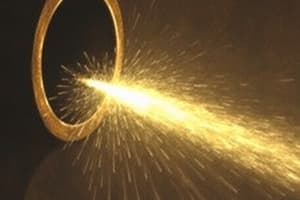Podcast
Questions and Answers
Which of the following best describes the modern electrochemical theory of corrosion?
Which of the following best describes the modern electrochemical theory of corrosion?
- Corrosion due to direct contact with corrosive gases
- A purely chemical reaction between metal and acid
- Direct oxidation of metal by oxygen
- An electrochemical reaction with anodic metal oxidation and cathodic oxidant reduction (correct)
According to Faraday's Laws, what must be equivalent in a corroding piece of metal?
According to Faraday's Laws, what must be equivalent in a corroding piece of metal?
- The surface area of the anode and cathode
- The conductivity of the electrolyte and the metal
- The mass of the anode and cathode
- The rates of anodic and cathodic reactions (correct)
What is the most important cathodic reaction in acids, according to the information provided?
What is the most important cathodic reaction in acids, according to the information provided?
- Oxygen reduction
- Chloride reduction
- Hydrogen evolution (correct)
- Metal oxidation
Why can rust encourage further corrosion?
Why can rust encourage further corrosion?
What characterizes a metal surface that retards further corrosion?
What characterizes a metal surface that retards further corrosion?
How do aggressive ions like chloride affect corrosion?
How do aggressive ions like chloride affect corrosion?
What is the unit typically used to measure weight loss per unit area per unit time in corrosion studies?
What is the unit typically used to measure weight loss per unit area per unit time in corrosion studies?
How does increased water flow rate typically affect corrosion in a cooling water system?
How does increased water flow rate typically affect corrosion in a cooling water system?
What is the general mechanism by which a corrosion inhibitor protects a metal surface?
What is the general mechanism by which a corrosion inhibitor protects a metal surface?
What is a key consideration when using anodic inhibitors, to avoid localized attack?
What is a key consideration when using anodic inhibitors, to avoid localized attack?
What is the function of cathodic inhibitors in cooling systems?
What is the function of cathodic inhibitors in cooling systems?
Why are mixed inhibitors often used instead of using only anodic inhibitors?
Why are mixed inhibitors often used instead of using only anodic inhibitors?
What is electrochemical control of corrosion?
What is electrochemical control of corrosion?
What is cathodic protection, and under what condition can it be applied?
What is cathodic protection, and under what condition can it be applied?
Which of the following is the correct formula for chromium sesquioxide, the protective film in stainless steel?
Which of the following is the correct formula for chromium sesquioxide, the protective film in stainless steel?
What is 'galvanic couple'?
What is 'galvanic couple'?
Which of the following are among the main functional groups capable of forming chemisorbed bonds with metal surfaces?
Which of the following are among the main functional groups capable of forming chemisorbed bonds with metal surfaces?
What is weight loss analysis used for?
What is weight loss analysis used for?
In the given experiment, what percentages of NaCl solution were used to study the corrosion inhibition efficiency of mild steel?
In the given experiment, what percentages of NaCl solution were used to study the corrosion inhibition efficiency of mild steel?
Why is it important to have a reliable means of removing corrosion product without disrupting the metal substrate during weight loss measurement?
Why is it important to have a reliable means of removing corrosion product without disrupting the metal substrate during weight loss measurement?
What surface analysis results were observed on electrodes treated with zinc ions?
What surface analysis results were observed on electrodes treated with zinc ions?
What is the standard electrochemical potential of zinc (Zn) and iron (Fe)?
What is the standard electrochemical potential of zinc (Zn) and iron (Fe)?
Why does mild steel exhibit a reduced corrosion rate when exposed to zinc ions?
Why does mild steel exhibit a reduced corrosion rate when exposed to zinc ions?
What effect does the adsorption of imidazole molecules have on the corrosion rate of mild steel?
What effect does the adsorption of imidazole molecules have on the corrosion rate of mild steel?
What is the influence of nitrogen atoms in the imidazole ring in facilitating corrosion inhibition?
What is the influence of nitrogen atoms in the imidazole ring in facilitating corrosion inhibition?
How does the presence of a Zn-imidazole complex affect the corrosion of mild steel?
How does the presence of a Zn-imidazole complex affect the corrosion of mild steel?
According to the study, which of the tested corrosion inhibitors demonstrated the best corrosion inhibition properties?
According to the study, which of the tested corrosion inhibitors demonstrated the best corrosion inhibition properties?
According to the experiment results, what is the effect of increased $Zn^{2+}$ ion concentration on the corrosion rate of mild steel?
According to the experiment results, what is the effect of increased $Zn^{2+}$ ion concentration on the corrosion rate of mild steel?
The corrosion map of India was prepared by which entity?
The corrosion map of India was prepared by which entity?
In electrochemical control of corrosion, what is the result of passing electrons into the metal and reaching the metal/electrolyte interface?
In electrochemical control of corrosion, what is the result of passing electrons into the metal and reaching the metal/electrolyte interface?
What does the Galvanic Series predict?
What does the Galvanic Series predict?
What is meant by 'local cell action'?
What is meant by 'local cell action'?
What conditions might lead to localized corrosion cells?
What conditions might lead to localized corrosion cells?
What factors influence the determination of the corrosion rate under specific exposure conditions?
What factors influence the determination of the corrosion rate under specific exposure conditions?
Which disaster was directly attributed to a navigational error, even though corrosion in pipelines and equipment can lead to disastrous leaks in the oil industry?
Which disaster was directly attributed to a navigational error, even though corrosion in pipelines and equipment can lead to disastrous leaks in the oil industry?
The surface of a mild steel coupon immersed in a 3% NaCl solution was analyzed. Which of the following would indicate that $Zn^{2+}$ ions have formed a protective barrier?
The surface of a mild steel coupon immersed in a 3% NaCl solution was analyzed. Which of the following would indicate that $Zn^{2+}$ ions have formed a protective barrier?
If, with increasing exposure time, a marginal shift in the potential of mild steel coupons towards a more anodic potential is observed, what is the likely interpretation?
If, with increasing exposure time, a marginal shift in the potential of mild steel coupons towards a more anodic potential is observed, what is the likely interpretation?
The combined effect of Imidazole and zinc ions as a corrosion inhibitor is known as?
The combined effect of Imidazole and zinc ions as a corrosion inhibitor is known as?
Flashcards
What is corrosion?
What is corrosion?
Deterioration of metals by chemical interaction with the environment.
Chemistry of Corrosion
Chemistry of Corrosion
Metals in a metastable state lose energy by reverting to original states.
Anodic corrosion
Anodic corrosion
Electrochemical reactions where iron goes into solution as ferrous ions.
Cathodic reaction
Cathodic reaction
Signup and view all the flashcards
Mixed electrode
Mixed electrode
Signup and view all the flashcards
Chloride's effect on Corrosion
Chloride's effect on Corrosion
Signup and view all the flashcards
Corrosion inhibitors
Corrosion inhibitors
Signup and view all the flashcards
Inhibitor Mechanism
Inhibitor Mechanism
Signup and view all the flashcards
Coating metal
Coating metal
Signup and view all the flashcards
Alloying Metal
Alloying Metal
Signup and view all the flashcards
Corrosion inhibitor
Corrosion inhibitor
Signup and view all the flashcards
Anodic Inhibitors
Anodic Inhibitors
Signup and view all the flashcards
Cathodic inhibitors
Cathodic inhibitors
Signup and view all the flashcards
Cathodic protection
Cathodic protection
Signup and view all the flashcards
Adsorption type cI
Adsorption type cI
Signup and view all the flashcards
Study Notes
- The study investigates corrosion inhibition in mild steel within a saline solution containing zinc ions (Zn2+) and imidazole.
- The study was submitted to the University of Calicut for a Bachelor of Science in Chemistry degree.
- The research was conducted at N.S.S. College, Nemmara, under the guidance of Dr. Priya S.
- The project report certifies that the corrosion-inhibition study was carried out by 6th semester B.Sc. Chemistry students under the supervision of Dr. Priya S.
- The project report declares that the work is a genuine record of research done under guidance from Dr S. Priya S.
- Corrosion is the deterioration of materials through chemical interaction with their environment, generally referring to the degradation of metals. Modern corrosion science began early in the twentieth century, studying metallic corrosion since the Industrial Revolution.
- Electrochemical theory describes metallic corrosion as a coupled electrochemical reaction involving anodic metal oxidation and cathodic oxidant reduction, applicable in both wet and dry oxidation at various temperatures.
- The consequences of corrosion depend on exposure, application, and long-term performance, significantly affecting the safe operation of equipment and structures.
- Metals obtained from ores possess high energy and tend to revert to lower energy states, resulting in corrosion. Corroded metal loses mechanical strength and becomes unusable.
- Corrosion reactions are electrochemical; iron dissolves as ferrous ions at anodic sites, releasing electrons.
- Electrons pass to cathodic sites, reacting with reducible electrolyte components. Anodic and cathodic reaction rates are equivalent, determined by the corrosion current. Electrolyte conductivity influences corrosion cell operation.
- The corroding metal is a "mixed electrode" with simultaneous anodic and cathodic reactions.
- The most common electrochemical reactions in iron corrosion include:
- Anodic reaction (corrosion): Fe → Fe2+ + 2e-
- Cathodic reactions (simplified): 2H+ + 2e- → H2 or H2O + O2 + 2e- → 2OH-
- Oxygen reduction is most important in pH range 6.5–8.5. This is usually accompanied by solid corrosion debris.
- Pure iron (II) hydroxide is white, but the initial corrosion product is greenish due to partial oxidation. Further reactions can result in reddish rust which is a complex mixture of trace elements.
- Rust encourages further corrosion due to its porous and absorbent nature.
- A protective surface film retards further corrosion.
Factors Controlling Corrosion Rate
- Establishing anodic/cathodic locations concentrates damage; metals with differing electrochemical properties create a galvanic couple.
- Galvanic effects can be predicted by studying Galvanic Series, which list metals and alloys potentials in a corrosive environment, like seawater. More noble metals extract electrons from more negative ones.
- Aggressive ions like chloride prevent protective oxide film formation on metal surfaces and increase corrosion, NaCl is used winter de-icing and marine environments.
- Sulphur dioxide from fuel combustion dissolves in moisture, creates an acidic electrolyte stimulating anodic/cathodic reactions.
- Weight loss per unit area per unit time [mdd - milligrams per square decimeter per day].
- Rate of penetration [mpy - mils per year]
- Surface condition impacts rate of corrosion
- pH range of 4-10 can impact the rate of corrosion
- Oxygen content increase usually increases corrosion
- Flow rate increase can increase the rate of corrosion
- Water type can impact corrosion rates
Corrosion Inhibitors
- A known method of corrosion protection is using a corrosion inhibitor
- These methods are popular in industry due to low cost and easy practice
- Inhibitors are materials or a combination of materials used in small concentration within aggressive environments prevent or minimize corrosion.
Mechanism of inhibitor is one or a number of three means:
- Inhibitor chemically absorbs over time [chemisorption], creating protective film over metal
- Inhibitor leads to creation of film to protect base metal
- Inhibitor reacts to corrosion present within environments and creates a complex
- There are environmentally friendly corrosion inhibitors called "green" corrosion inhibitors.
- Chemicals can be synthetic or natural for corrosion inhibition.
- Chemical nature is organic or inorganic
- It can perform as a stand alone mix The present work identified methylene blue and poly vinyl pyrrolidone as corrosion inhibitors in mitigating corrosion rate of mild steel coupons in 3%, 5% and 10% sodium chloride solution.
Conditioning the Metal
- Can be broken down into 2 sub-groups:
- Coating the metal creates a layer of corrosion resistance
- Alloying can produce more resistant alloys like chromium or nickel
Conditioning the Corrosive Environment:
- Oxygen can be removed from water systems where pH is 6.5-8.5
- The oxygen is a component that is required for corrosion and the removal of it could be done through usage of sulphite.
- This method is not useful for open evaporative systems due to the constant access of oxygen in the atmosphere
Corrosion Inhibitors
- Chemical additives can reduce rate of metal wastage within corrosive environments
- Anodic Inhibitors interfere with the anodic process. If an anodic inhibitor isn't around the inhibitor can create pitting corrosion
- Cathodic Inhibitors reduce the oxygen in major cathodic reactions in cooling systems
- Adsorption-type corrosion Inhibitors use organic inhibitors and works through adsorption
Real-life Consequences of Corrosion:
- Titanic Disaster (1912): Corrosion of the ship’s metal hull contributed to its vulnerability, resulting in over 1,500 deaths.
- Exxon Valdez Oil Spill (1989): Corrosion of pipelines led to environmental damage and marine ecosystem costs.
- Piper Alpha Oil Rig Disaster (1988): Corroded safety equipment led to a catastrophic explosion, causing 167 deaths and major safety reforms.
- Silver Bridge Collapse (1967): A corroded eye-bar caused the bridge to collapse, resulting in 46 deaths and better inspection protocols.
- Flint Water Crisis (2014): Lead pipes caused lead contamination, resulting in health issues for thousands.
- Challenger Space Shuttle Disaster (1986): Corrosion in O-rings led to the failure of the rocket booster, costing 7 crew member's lives
- Mianus River Bridge Collapse (1983): Corroded supports led to the bridge collapse, killing 3 and improving inspections.
- Global Shipping Industry: Corrosion of ships leads to billions in maintenance costs
- San Onofre Nuclear Plant (2010s): Stress corrosion cracking led to plant shutdown and billions of dollars in costs needed for maintenance.
Electrochemical Control
- Corrosion studied by measuring changes in metal potential with time with applied electrical currents.
- Corrosion is controlled by passing anodic or cathodic currents into the metal
- Cathodic protection is utilized by passing electrons through suitable material to protect metal
- Protection can be achieved lowering the potential of the metal surface that is being protected by 300 or 400 mV
- Anodic dissolution of metal uses materials like aluminum or magnesium that are low in galvanic series
Corrosion Map of India:
- The map was prepared by the Corrosion Advisory Bureau, Metals Research Committee, Jamshedpur.
- It describes corrosion patterns in various regions, categorizing them as severe, most severe, and mild environments.
- Weight loss analysis is simplest method to test plant/equipment.
- Follows ASTM protocol. Involves weighing metal samples, exposing them, cleaning of the coupons, and reweighing.
- Weight loss is converted into a rate of loss (CR - corrosion rate/ ML - metal loss)
- Formula is Corrosion Rate = Weight loss x Constant / Alloy Density x Area exposed x Exposure time
- The technique requires a coupon and a coupon holder
- It is the oldest and most used method for corrosion loss
Coupon preparation:
- Important that testing is done before/after to assure accurate data.
- Surface cleaning includes bead,sand,stone, and grinding tools.
- Coupons of 25.8cm2 were cut for testing
- Mild steel was dried/weighed before performing tests with sodium chloride
Composition Of Well Water
- Water requisite was added to make NaCl 3% to simulate sea water
- Composition of ions were studied
- Mild steel was studied with 3% NaCl, with zinc, imidazole
Results Weight Loss Analysis
- Steel samples were exposed to sodium chloride for 25 days
- Samples cleaned and weighed again
- Density: 7.87 g/cm3 Area exposed: 25.8 g/cm2
- Weight loss rate in all different types of exposure:
- NaCl(alone) - 1.446 mills
- NaCl +1g Zn2+ - 1.3149 mills
- NaCl +2g Zn2+ - 0.8766 mills
- NaCl+3g Zn2+ - 0.4383 mills
- NaCl +2g Imidazole - 1.095 mills
- NaCl+2g Imidazole+2g Zn2+ - 0.4383 mills
- NaCl +3 ml Leaf Extract - 0.8766 mills
- As zinc ions increase weight loss and corrosion decreases, even with corrosive chloride
- 3% NaCl is higher due to chloride and destruction of ions
- Zn layer created provides protection in presence of Zn2+ ions
- Electrodes study confirms coatings with zinc.
- Zinc electrochemical potential is -0.76 V
- Iron is -0.44V
- Protective barrier formed when mild steel exposed
- Exposure rate decreased with rate
- Mild steel dipped spinach showed results to tested coupons
- Mild steel experienced less rate of corrosion with imidazole- Nitrogen atoms bind to metals and create protection,
- Zinc complex and Imidazole exposure significantly less corrosion- effective corrosion complex
- Bubble formations found on steel, surface analyzed under microscope
- Electro Chemical: open circuit potent measurement-
- OCP for steel immersed with concentrations of solution monitored.
- Shift shown as function of time.
- 3% NacL shifted towards Catholic region.
- Zn2+ ions increased. OCP shifted from the Anaodic regions. Ions form layer barrier for Electrons
- Coupes showed catholic potential values
- Shift had shift of anodic potential- Zin-imidazole showed shift towards cathodic.. alignment correlated to weight loss Additional comparison the potential shift of zinc show little relative to electrodes in NAcl.
- Mild stell- different weight loss in zinc
- Loss of study concentration of zing can impact corrosion- study of corrosion due to synergetic effect
Studying That Suits You
Use AI to generate personalized quizzes and flashcards to suit your learning preferences.




